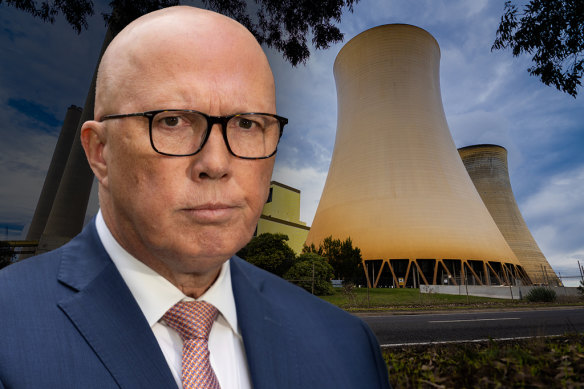This was published 1 year ago
Dutton’s claim nuclear waste would be size of Coke can ‘hard to swallow’
By Mike Foley and Bianca Hall
Opposition Leader Peter Dutton’s claim that the annual waste generated by a small modular nuclear reactor amounts to the size of a Coke can is a hard claim to swallow, experts say, with such facilities likely to generate multiple tonnes of high-level radioactive waste each year.
Dutton this week revealed the locations where a Coalition government would build seven nuclear reactors, vowing to overturn the federal ban on the controversial energy source and complete the first two facilities by 2037.

Peter Dutton has proposed building seven new nuclear power stations.Credit: The Age
He spruiked nuclear as a low-waste energy source.
“If you look at a 450-megawatt reactor, it produces waste equivalent to the size of a can of Coke each year,” Dutton said on Tuesday.
Multiple experts told this masthead a 450-megawatt reactor referenced by Dutton would generate many tonnes of waste a year.
“Dutton’s Coke can claim is very hard to swallow,” said Australian Conservation Foundation nuclear policy analyst Dave Sweeney.
“It would be a very large can of Coke.”
The opposition’s nuclear policy envisions a mix of traditional large-scale reactors and small modular reactors. Known as SMRs, this technology is currently under development and not yet in commercial deployment.
Large-scale reactors, which have been deployed in 32 countries around the world, have a typical capacity of 1000 megawatts and generate about 30 tonnes of used fuel a year. This includes high-level radioactive waste that is toxic to humans for tens of thousands of years, as well as weapons-grade plutonium.
SMRs are still under commercial development and expert opinion is divided over whether they would produce more or less waste per unit of energy, compared to a large reactor.
Emeritus Professor Ian Lowe of Griffith University’s school of environment and science said it was safe to say an SMR would generate many tonnes of waste per year, and it was likely that waste would be more radioactive than the waste from a large-scale reactor.
“For a 400-megawatt SMR, you’d expect that to produce about six tonnes of waste a year. It could be more or less, depending on the actual technology but certainly multiple tonnes a year,” he said.
“They run on highly enriched uranium and produce a much nastier and a much more intractable set of radioactive waste elements that have to be treated.”
Dutton’s Coke can reference appears to be based on previous claims by the global nuclear industry, which says the waste a large-scale reactor would generate from supplying one person’s annual energy needs would fill one can.
While the World Nuclear Association says nuclear waste has not caused harm to human health, opponents point to the potential dangers associated with storing the radioactive waste and for the spent fuel from nuclear reactors to be used to make nuclear weapons.
“Nuclear waste is hazardous, it’s carcinogenic, and it’s mutagenic; so it can cause cancer, can change genetic structure, and it remains a considerable hazard that requires effective isolation from people in the wider environment for periods of 100,000 years,” said Sweeney.
There are no permanent repositories anywhere in the world capable of storing high-level radioactive waste, but Finland and Sweden are preparing to open deep underground storage sites.
Nuclear waste is sealed off and stored on-site at most nuclear plants around the world.
By way of comparison, a 1000-megawatt coal plant, the same size as a large-scale nuclear reactor, burns more than 3 million tonnes of coal a year and generates around 300,000 tonnes of ash.
As of 2023, 110 wind farms were operating across Australia. There are currently 31 wind farms with 599 turbines more than 15 years old, according to the Clean Energy Council.
An estimated 15,000 tonnes of blade composite waste will be created in Australia by 2034, and up to 4000 tonnes in any given year. The Clean Energy Council said at least 85 per cent of a wind turbine’s mass can be recycled – mostly steel, aluminium, copper and iron.
A report by the University of NSW Australian Centre of Advanced Photovoltaics forecast the total volume of disused solar panels would reach a total volume of 1 million tonnes by 2035. That means around 100,000 tonnes of solar panel waste would be generated each year.
About 95 per cent of a solar panel can be recycled. However, there is not yet a large-scale recycling industry in place to handle the industry’s growing waste.
Dutton’s office was contacted for comment.
Cut through the noise of federal politics with news, views and expert analysis. Subscribers can sign up to our weekly Inside Politics newsletter.